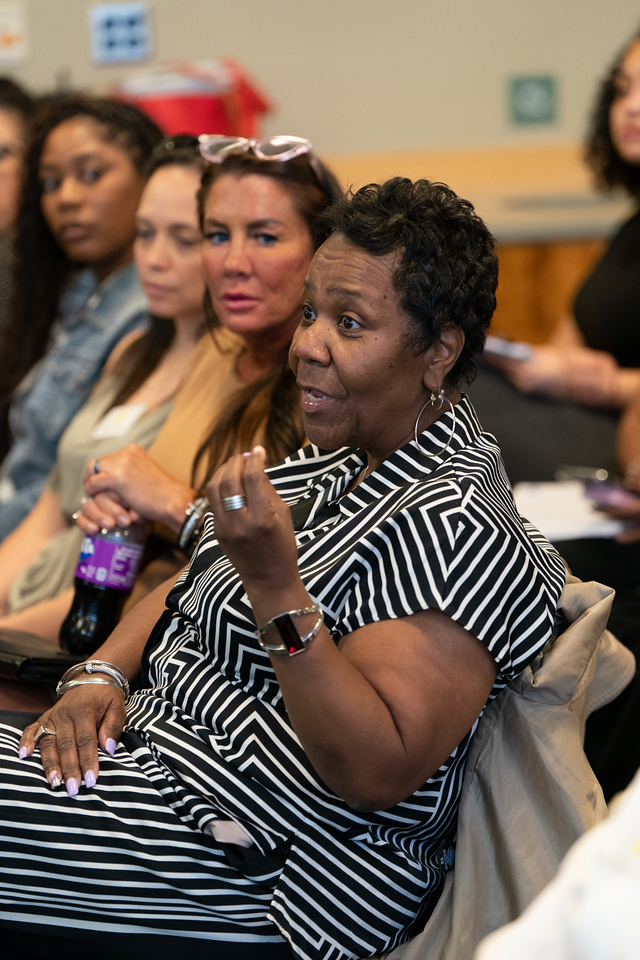Centering Collaboration to Close Gaps for Overlooked Trafficked Children
The 2025 Maryland Child Trafficking Awareness Conference, held at Towson University on June 5, brought together advocates, practitioners, students, and survivors for a day focused on building more inclusive, coordinated responses to child trafficking — especially for populations that have historically been overlooked or underserved.
Now in its ninth year, the conference was organized in partnership by the University of Maryland, Baltimore (UMB) Center for Violence Prevention, the University of Maryland School of Social Work’s Prevention of Adolescent Risks Initiative, the Maryland Governor’s Office of Crime Prevention and Policy, and the Maryland Human Trafficking Task Force. With the theme of “Transforming Together: Collaborative Strategies for Statewide Growth,” this year’s event emphasized the power of cross-sector coordination and gender-responsive care.
In her opening remarks, Nadine Finigan-Carr, PhD, executive director of the Center for Violence Prevention and founding director of the Prevention of Adolescent Risks Initiative, reflected on the conference’s impact.

A participant at the 2025 Maryland Child Trafficking Conference asks a question during a breakout session.
“For almost a decade, we have provided this conference as a labor of love in support of so many who work with victims of human trafficking in Maryland and beyond,” she said. “It’s amazing to think that what we created has had such a lasting impact on how we as Marylanders respond and support victims of human trafficking.
“I am glad to see that we have moved from awareness to responding to collaboration — because what we need to do is collaborate among varied audiences, from local communities, service providers, and policymakers,” she added.
A Keynote Focused on Sustainable Solutions
The conference’s keynote speaker, Hollie Nadal, survivor leadership program coordinator at The Human Trafficking Legal Center, urged attendees to go beyond reactive measures and commit to creating long-term, community-based systems of care. Drawing on her own lived experience as a trafficking survivor, Nadal emphasized the need for survivor-informed strategies at every level of response.
Her address, titled “Building Sustainable Solutions Through Collaboration,” challenged systems leaders and front-line professionals to address root causes — such as housing instability, systemic racism, and behavioral health inequities — while designing services that reflect the identities and experiences of trafficking survivors.
“Any child can be vulnerable, but we must be real about which children are most vulnerable and why,” Nadal said. She called for earlier, equity-driven interventions and more inclusive service models that recognize the trauma of exploitation and the resilience of survivors. “If your program or policy is only reaching some kids, it’s not working. It’s time to redesign with all of them in mind.”
Centering Boys and Men in the Anti-Trafficking Response
In a powerful plenary session titled “Risks, Trajectories, and Treatment in the Commercial Sexual Exploitation and Trafficking of Male Youth,” Nathan Earl, co-director of Men’s Haven Health, focused on addressing the historic exclusion of boys and men in anti-trafficking research and policy.
“We knew that there was an underreporting of boys who had been trafficked for sex, and part of that challenge at the policy and system level was just a lack of data,” Earl said. He presented findings from a scoping review examining unique risk factors, health outcomes, and service gaps affecting male survivors, and called for trauma-informed, gender-responsive strategies.
“Depending on region, as many as half of all children trafficked for sex are boys,” he stressed. “Unless we have a clear and accurate view of who is being impacted, policy and programs won’t reach the most marginalized youth in our communities.”
Lessons from the Field
The conference featured concurrent breakout sessions designed to provide attendees with actionable strategies and real-world insights across sectors. Topics included online exploitation, familial trafficking, housing for child victims, hidden references in pop culture, and building effective partnerships between education, legal systems, and community organizations.
For professionals like Veronica Clark, assistant regional administrator with Maryland’s Division of Parole and Probation, the sessions offered fresh perspectives and practical tools to take back to their agencies.
“Even though I work with adults, I found that there were some things we can look at to identify red flags,” Clark said. “We can look for those red flags when we work with [offenders], listen to them, and be observant of their behaviors. They might be the perpetrators.”
Chloe Brackens, president of the Freedom Connection Rotaract at George Mason University, said the experience expanded her understanding of survivor-centered approaches and how organizations support one another to improve care.
“I think the creativity of collaboration was hugely important in that conversation, as well as honesty and being victim-centered,” she said. “It’s one thing on paper to say we should collaborate. It’s another thing to actually do the work with people — and conferences like this help build the relationships that make victim-centered approaches effective.”



